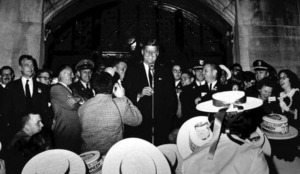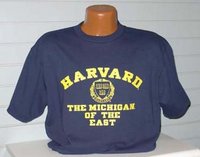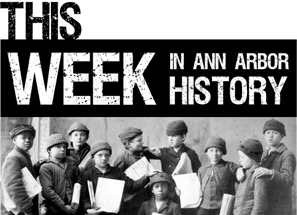A special milestones edition, commemorating the Peace Corps announcement
This Week in Ann Arbor History is dominated by a milestone in the city's history, when presidential candidate and Massachusetts Senator John F. Kennedy laid out his vision for the Peace Corps on the eve of the 1960 Presidential Election. Kennedy's opponent that year was then-Vice President Richard Nixon.
The story of Kennedy's historic speech, which will be commemorated this week with a full slate of events on campus, has been told many times since, but the Ann Arbor News wrote the first draft of history.Â

JFK at the Michigan Union. Friday October 14, 1960.
Fifty Years Ago: JFK envisions the Peace Corps
"Aid New Nations," read the News' above-the-fold headline on Friday, Oct. 14, the day of Kennedy's early-morning speech on the steps of the Michigan Union. Kennedy "asked the students how many would be willing to spend time in Africa and in other areas working for the development of emerging nations in the cause of world peace," the News reported in an early mention of what would become the Peace Corps. "Kennedy said he was not asking the students for their support in the 1960 campaign, but rather their support for their country in the next decade."
According to the University of Michigan's Peace Corps website, more than 200,000 Americans and 2,200 Michigan grads have participated in the service corps since 1960. Kennedy's speech is commemorated with a plaque and a marker at the Union's State Street entrance.
Two different crowds awaited Kennedy's appearance in Ann Arbor — one that stayed up all night to watch Kennedy speak at the Michigan Union, and another that woke up early to see Kennedy off at the train station.
As Fred Klein reported, the group at the train station was more orderly, while the Union crowd was a bit more restless.
The Union crowd had been waiting for three hours by the time Kennedy showed at 2 a.m., while the train station crowd mostly formed in the last hour before the senator left town at about 8:50 a.m.
"We Want Our Government Run on Time — with Nixon," read one sign in the crowd, but the bulk of the 8,000 person crowd at the Michigan Union was willing to give Kennedy the benefit of the doubt.
Whomever the senator had offended by his late arrival, he won over by referring to Harvard, his alma mater, as "the Michigan of the East," a distinction that lives on in T-shirt form today.

Senator John F. Kennedy called his alma mater, Harvard, the "Michigan of the East" before a crowd of thousands at the Michigan Union. He also laid out his vision for the Peace Corps.
After the speech, Kennedy gave a smaller talk to a group of local adults and high schoolers and left town at about 8:50 a.m., where he was sent off by the more patient train station crowd. About 5,000 people showed up for that.
Vice President Nixon stopped through the area two weeks later on a "whistle-stop" tour. Even though he drew more than 15,000 supporters in Jackson, twice what Kennedy's speech got in Ann Arbor, he didn't stay overnight and didn't establish any programs that still exist today. His trip is much less heralded than Kennedy's, 50 years later.

100 Years Ago: New rules cause scoring woes for Yost's gridders
College football was still a pretty primitive game 100 years ago. The forward pass was just a few years into its existence, the same 11 men played both ways, the entire game, first downs had only recently been lengthened to 10 yards from 5. The Michigan football program was still 5 seasons away from assigning numbers to players' jerseys.
After Michigan opened the 1910 season with a 3-3 snoozer against Case, Ann Arbor's Daily Times News sports page ran a story explaining how new rules for the 1910 season were affecting the product on the field.
As the paper explained it, the score was partially to blame on the ban on "mass plays," rushing plays wherein a runner's teammates push and pull him along for extra yardage, particularly in goal line situations. For a recent example of the illegal tactic, see the infamous "Bush Push" play from USC-Notre Dame in 2005.
Michigan and Case had both driven the ball inside the opponent's five yard line several times in the season opener, but neither team scored a touchdown. "The reason is not to too far to seek," wrote the News. "One man, working practically alone and unaided, cannot hope to penetrate the defense...of even an ordinary opponent consistently enough to make many touchdowns."
Michigan had a get-right game against the rival Michigan Agricultural College Aggies that weekend, winning 6-3, another low-scoring affair affected by college football's new rule. Today the Aggies are known as the Michigan State Spartans.
The Daily Times News also reported the Notre Dame football team used its bye week to come to Ann Arbor to scout the Wolverines and the Aggies, in anticipation of upcoming games against the schools.
But scouting from the stands at Ferry Field was as close as the Irish would get to meeting the Wolverines on the gridiron. For decades.
After the Irish won their first game in six attempts in 1909, they wouldn't face the Wolverines in football until a home-and-home series in 1942 and 1943, which they split. The schools didn't meet again in football until 1978.
Michigan and Notre Dame, two of college football's winningest programs, are thought of as staples on one another's schedules today. But they only played twice from 1910 to 1977, a Michigan-initiated and perpetuated snubbing that spanned from the early days of Fielding Yost, the entire tenure of Fritz Crisler, minus the two-year blip, and almost halfway into the career of Bo Schembechler.
James David Dickson can be reached at JamesDickson@AnnArbor.com.

